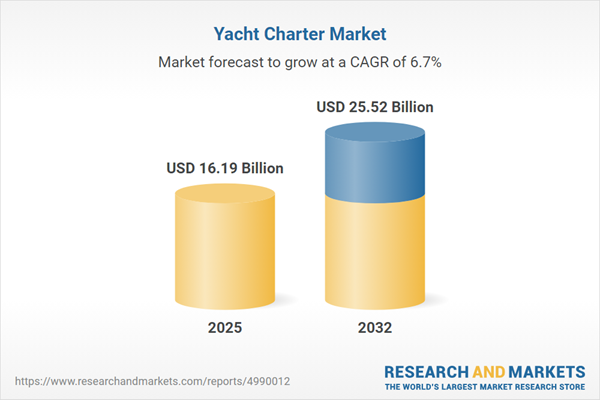Speak directly to the analyst to clarify any post sales queries you may have.
The yacht charter market is undergoing rapid transformation as shifting client preferences, digital advancements, and growing sustainability concerns create new challenges and opportunities for industry executives. Senior leaders must proactively adapt strategies to maintain relevance and compliance while meeting evolving expectations.
Market Snapshot: Yacht Charter Market Size & Growth
The yacht charter market is valued at USD 15.15 billion in 2024, forecast to increase to USD 16.19 billion by 2025 and reach USD 25.52 billion by 2032. This projected growth, marked by a Compound Annual Growth Rate (CAGR) of 6.72%, points to sustained sector expansion. Key growth drivers include increasing demand for premium travel experiences, expanded use of digital booking platforms, and expanded sustainability initiatives. In response, industry organizations are refining investment strategies and evolving operating models to maintain competitiveness amid changing regulatory and economic landscapes.
Scope & Segmentation: Yacht Charter Market Analysis
- Vessel Types: Catamarans, motor yachts, ketches, schooners, and monohulls are offered, each supporting both luxury and standard travel requirements for leisure and business occasions.
- Charter Types: Bareboat, crewed, and customized charter packages cater to private travelers, corporate groups, families, and exclusive gatherings, with flexible options to meet varied service demands.
- Trip Durations: Providers offer short excursions and extended journeys, responding to both event-driven demand and growing interest in longer and executive-level voyages.
- Price Ranges: Entry-level to luxury pricing structures enable targeted segmentation, allowing operators to serve distinct customer profiles while optimizing revenue streams.
- Booking Channels: Specialized broker networks, digitized direct booking platforms, and advanced global interfaces streamline customer access and enhance relationship management efficiency.
- Geographic Segments: The Americas, Europe, Middle East & Africa, and Asia-Pacific require differentiated operating models and compliance strategies, shaped by regional market drivers and unique regulatory environments.
- Companies Analyzed: The competitive landscape focuses on major operators emphasizing technology adoption and operational leadership, including Dream Yacht Charter SAS, The Moorings Yacht Charters LLC, Boatsetter, Fraser Yachts Limited, Burgess International, Northrop & Johnson, Y.CO Company, Azimut Benetti, Sunseeker International, and Fraser Yachts.
This segmentation allows executives to tailor operational processes and prioritize modernization, leveraging digital and sustainable solutions to address diverse regional and client needs.
Key Takeaways for Senior Decision-Makers
- Digital management solutions are enabling streamlined operations and improved global reach, while providing advanced client engagement and supporting data-driven service evolution.
- As demand for personalized and private experiences rises, investment in specialized crews and high-end onboard facilities becomes essential for service differentiation across diverse client bases.
- Adapting service models to reflect regional regulations and local client expectations strengthens operational resilience and enables sustained competitive positioning.
- Integrating sustainability within business practices is becoming critical for maintaining brand reputation and accessing new markets amid complex compliance demands.
- Enhanced workforce training supports consistent high-touch service delivery, addressing the expectations of prominent and discerning customer segments.
- Building robust supply chains and expanding operational capacity increases adaptability, positioning operators to manage changing external market conditions.
Tariff Impact: Navigating US Tariffs on Yacht Charter Operations
With new US tariffs expected in 2025, yacht charter companies are adapting by diversifying supplier networks, refining procurement strategies, and considering domestic production as part of their contingency planning. These approaches are helping to stabilize operating costs and uphold service quality amid unpredictable international trade dynamics.
Methodology & Data Sources
This market intelligence is developed from in-depth executive interviews, targeted customer surveys, and reviewed maritime data. Supplementary insights from international maritime regulators, trade publications, and comprehensive sector databases increase analytical rigor, equipping leaders with actionable information for decision-making.
Why This Report Matters: Support for Yacht Charter Market Stakeholders
- Helps senior executives realign operational models and recalibrate investment priorities as global and local market conditions evolve.
- Offers clear frameworks for assessing technology adoption and process improvements crucial for ensuring sustainability and long-term business growth.
- Presents guidance for digital transformation, enhanced service delivery, and regulatory compliance as operational complexity increases across regions and market segments.
Conclusion
This report enables executive teams to strengthen compliance frameworks, advance digital strategies, and build resilient operational practices that align with the evolving yacht charter landscape.
Additional Product Information:
- Purchase of this report includes 1 year online access with quarterly updates.
- This report can be updated on request. Please contact our Customer Experience team using the Ask a Question widget on our website.
Table of Contents
3. Executive Summary
4. Market Overview
7. Cumulative Impact of Artificial Intelligence 2025
Companies Mentioned
The companies profiled in this Yacht Charter market report include:- Dream Yacht Charter SAS
- The Moorings Yacht Charters LLC
- Boatsetter, Inc.
- Fraser Yachts Limited
- Burgess International Limited
- Northrop & Johnson Holdings Limited
- Y.CO Company
- Azimut Benetti S.p.A.
- Sunseeker International Limited
- Fraser Yachts
Table Information
| Report Attribute | Details |
|---|---|
| No. of Pages | 182 |
| Published | November 2025 |
| Forecast Period | 2025 - 2032 |
| Estimated Market Value ( USD | $ 16.19 Billion |
| Forecasted Market Value ( USD | $ 25.52 Billion |
| Compound Annual Growth Rate | 6.7% |
| Regions Covered | Global |
| No. of Companies Mentioned | 11 |









